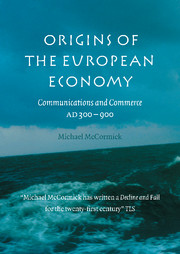Book contents
- Frontmatter
- Dedication
- Contents
- List of maps
- List of figures
- List of tables
- List of charts
- Preface
- List of abbreviations
- Commerce, communications, and the origins of the European economy
- PART I THE END OF THE WORLD
- PART II PEOPLE ON THE MOVE
- PART III THINGS THAT TRAVELED
- PART IV THE PATTERNS OF CHANGE
- PART V COMMERCE
- Appendices
- Bibliography
- Index
Commerce, communications, and the origins of the European economy
Published online by Cambridge University Press: 05 February 2015
- Frontmatter
- Dedication
- Contents
- List of maps
- List of figures
- List of tables
- List of charts
- Preface
- List of abbreviations
- Commerce, communications, and the origins of the European economy
- PART I THE END OF THE WORLD
- PART II PEOPLE ON THE MOVE
- PART III THINGS THAT TRAVELED
- PART IV THE PATTERNS OF CHANGE
- PART V COMMERCE
- Appendices
- Bibliography
- Index
Summary
The Mediterranean world that appears in the pages that follow may sometimes seem a different place from the one that historians have imagined until now. It is a world whose long-buried air pollution is prompting scientists to hypothesize about the changing aggregate metal production of the Roman empire, even as ships that sank centuries ago emerge from the ghostly depths laden with the secrets of an age once thought dark. Archaeologists now plot the ebb and flow of exchange from the tons of Roman ceramic containers issuing from excavations, or the spread of Arab-style buttons and weighing scales across ninth-century Scandinavia. It is a world in which Merovingian relic collectors eye the shrines of Byzantine Asia Minor, and their Carolingian successors focus on those of the Arab Middle East. In the 790s, a word stemming from the Malay tongue of southeast Asia makes its way into a Carolingian book written 15 km from the Rhine. In the same years, the pope who welcomed Charles the Great into Rome was also credited with helping the bishops of Africa, and he was but the first of his age to engage on the opposite shore of the Mediterranean.
In this world, we meet the same Bulgarian aristocrat on the banks of the Tiber and the Bosporus. Jewish merchants trade at a European saint's fair and seek religious advice from learned rabbis living in Iraq, while Muslim businessmen from the Middle East report on the textile market of Rome.
- Type
- Chapter
- Information
- Origins of the European EconomyCommunications and Commerce AD 300–900, pp. 1 - 24Publisher: Cambridge University PressPrint publication year: 2002



